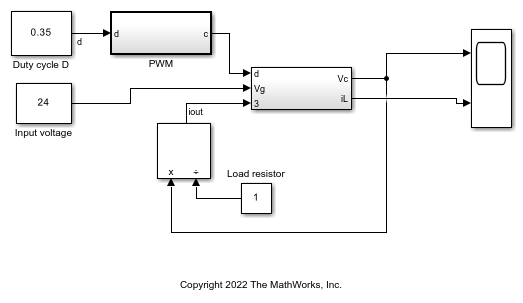Relay
在两个常量输出之间进行切换
库:
Simulink /
Discontinuities
HDL Coder /
Discontinuities
描述
Relay 模块的输出在两个指定值之间切换。打开中继时,它会一直保持打开,直到输入低于关闭点参数的值为止。关闭中继时,它会一直保持关闭,直到输入高于开启点参数的值为止。此模块接受一个输入并生成一个输出。
注意
如果初始输入介于 开启点与关闭点值之间,则初始输出是中继关闭时的值。
示例
Use Fixed-Step Zero-Crossing Detection for Faster Simulations
Use fixed-step zero-crossing detection to improve simulation performance.
端口
输入
输入信号,用于打开或关闭中继。
数据类型: single | double | int8 | int16 | int32 | int64 | uint8 | uint16 | uint32 | uint64 | Boolean | fixed point
输出
输出信号在由参数打开时的输出和关闭时的输出确定的两个值之间切换。
数据类型: single | double | int8 | int16 | int32 | int64 | uint8 | uint16 | uint32 | uint64 | Boolean | fixed point
参数
当输入超过此阈值时,中继打开。开启点值必须大于或等于关闭点。指定的开启点值大于关闭点可构建磁滞模型,指定两个值相等则可构建以该值为阈值的开关模型。
开启点参数会通过舍入到最邻近整数和饱和处理方法自动转换为输入数据类型。
编程用法
模块参数:OnSwitchValue |
| 类型:字符向量 |
| 值:标量 |
默认值:'eps' |
当输入超过此阈值时,中继关闭。关闭点的值必须小于或等于开启点。关闭点参数会通过舍入到最邻近整数和饱和处理自动转换为输入数据类型。
编程用法
模块参数:OffSwitchValue |
| 类型:字符向量 |
| 值:标量 |
默认值:'eps' |
当中继打开时的输出值。
编程用法
模块参数:OnOutputValue |
| 类型:字符向量 |
| 值:标量 |
默认值:'1' |
当中继关闭时的输出值。
编程用法
模块参数:OffOutputValue |
| 类型:字符向量 |
| 值:标量 |
默认值:'0' |
指定模块是执行基于采样还是基于帧的处理:
列作为通道(基于帧) - 将输入信号的每一列视为一个单独的通道(基于帧的处理)。
注意
基于帧的处理需要具有 DSP System Toolbox™ 许可证。
有关详细信息,请参阅Sample- and Frame-Based Concepts (DSP System Toolbox)。
元素作为通道(基于采样) - 将输入信号的每个元素视为一个单独的通道(基于采样的处理)。
可以使用输入处理指定模块是执行基于采样的处理还是基于帧的处理。有关这两种处理模式的详细信息,请参阅Sample- and Frame-Based Concepts (DSP System Toolbox)。
编程用法
模块参数:InputProcessing |
| 类型:字符向量 |
值:'Columns as channels (frame based)' | 'Elements as channels (sample based)' |
默认值:'Elements as channels (sample based)' |
指定采样时间间隔。要继承采样时间,请将此参数设置为 -1。有关详细信息,请参阅指定采样时间。
依赖关系
仅当您将此参数设置为 -1 以外的值时才可见。要了解详细信息,请参阅不建议设置采样时间的模块。
编程用法
要以编程方式设置模块参数值,请使用 set_param 函数。
| 参数: | SampleTime |
| 值: | "-1" (默认) | scalar or vector in quotes |
软件检查的输出范围的下限值。
软件使用最小值执行下列操作:
某些模块的参数范围检查(请参阅指定模块参数的最小值和最大值)。
定点数据类型的自动定标。
从模型生成的代码的优化。此优化可删除算法代码,并影响某些仿真模式(如 SIL 或外部模式)的结果。有关详细信息,请参阅使用指定的最小值和值进行优化 (Embedded Coder)。
提示
输出最小值不会对实际输出信号进行饱和处理或截断。请改用 Saturation 模块。
编程用法
要以编程方式设置模块参数值,请使用 set_param 函数。
| 参数: | OutMin |
| 值: | '[]' (默认) | scalar in quotes |
软件检查的输出范围的上限值。
软件使用最大值执行下列操作:
某些模块的参数范围检查(请参阅指定模块参数的最小值和最大值)。
定点数据类型的自动定标。
从模型生成的代码的优化。此优化可删除算法代码,并影响某些仿真模式(如 SIL 或外部模式)的结果。有关详细信息,请参阅使用指定的最小值和值进行优化 (Embedded Coder)。
提示
输出最大值不会对实际输出信号进行饱和处理或截断。请改用 Saturation 模块。
编程用法
要以编程方式设置模块参数值,请使用 set_param 函数。
| 参数: | OutMax |
| 值: | '[]' (默认) | scalar in quotes |
指定输出数据类型。可以将其设置为:
继承数据类型的规则,例如继承: 通过反向传播继承
内置数据类型的名称,例如
single数据类型对象的名称,例如
Simulink.NumericType对象计算结果为数据类型的表达式,例如
fixdt(1,16,0)
点击显示数据类型助手按钮  可以显示数据类型助手,这有助于您设置输出数据类型参数。
可以显示数据类型助手,这有助于您设置输出数据类型参数。
有关详细信息,请参阅 控制信号的数据类型。
编程用法
模块参数:OutDataTypeStr |
| 类型:字符向量 |
值:'Inherit: All ports same datatype' | 'Inherit: Inherit via back propagation' | 'double' | 'single' | 'int8' | 'uint8' | int16 | 'uint16' | 'int32' | 'uint32' | 'int64' | 'uint64' | 'boolean' | fixdt(1,16) | fixdt(1,16,0) | fixdt(1,16,2^0,0) | 'Enum: <class name>' | '<data type expression>' |
默认值:'Inherit: All ports same datatype' |
选择此参数可防止定点工具覆盖您对此模块指定的数据类型。有关详细信息,请参阅Lock the Output Data Type Setting (Fixed-Point Designer)。
编程用法
模块参数:LockScale |
| 类型:字符向量 |
值:'off' | 'on' |
默认值:'off' |
模块特性
数据类型 |
|
直接馈通 |
|
多维信号 |
|
可变大小信号 |
|
过零检测 |
|
扩展功能
C/C++ 代码生成
使用 Simulink® Coder™ 生成 C 代码和 C++ 代码。
HDL Coder™ 提供影响 HDL 实现和综合逻辑的额外配置选项。
此模块具有一个默认 HDL 架构。
| ConstrainedOutputPipeline | 通过移动设计中现有延迟的方式来放置在输出端的寄存器的数量。分布式流水线不会重新分发这些寄存器。默认值为 |
| InputPipeline | 要在生成的代码中插入的输入流水线阶段数。分布式流水线和受限输出流水线可以移动这些寄存器。默认值为 |
| OutputPipeline | 要在生成的代码中插入的输出流水线阶段数。分布式流水线和受限输出流水线可以移动这些寄存器。默认值为 |
该模块不支持使用浮点数据类型进行 HDL 代码生成。
PLC 代码生成
使用 Simulink® PLC Coder™ 生成结构化文本代码。
定点转换
使用 Fixed-Point Designer™ 设计和仿真定点系统。
版本历史记录
在 R2006a 之前推出
另请参阅
MATLAB Command
You clicked a link that corresponds to this MATLAB command:
Run the command by entering it in the MATLAB Command Window. Web browsers do not support MATLAB commands.
选择网站
选择网站以获取翻译的可用内容,以及查看当地活动和优惠。根据您的位置,我们建议您选择:。
您也可以从以下列表中选择网站:
如何获得最佳网站性能
选择中国网站(中文或英文)以获得最佳网站性能。其他 MathWorks 国家/地区网站并未针对您所在位置的访问进行优化。
美洲
- América Latina (Español)
- Canada (English)
- United States (English)
欧洲
- Belgium (English)
- Denmark (English)
- Deutschland (Deutsch)
- España (Español)
- Finland (English)
- France (Français)
- Ireland (English)
- Italia (Italiano)
- Luxembourg (English)
- Netherlands (English)
- Norway (English)
- Österreich (Deutsch)
- Portugal (English)
- Sweden (English)
- Switzerland
- United Kingdom (English)
